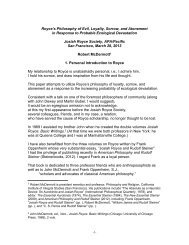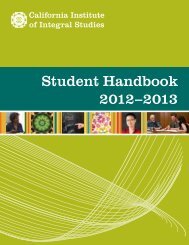AHP Perspective Feb Mar 2012.indd - California Institute of Integral ...
AHP Perspective Feb Mar 2012.indd - California Institute of Integral ...
AHP Perspective Feb Mar 2012.indd - California Institute of Integral ...
You also want an ePaper? Increase the reach of your titles
YUMPU automatically turns print PDFs into web optimized ePapers that Google loves.
PERSONALIZED MEDICINE<br />
THE FLOW OF FEELING<br />
From our vantage point, the energy<br />
<strong>of</strong> feelings works differently in<br />
different people depending on<br />
where they are along the boundary<br />
spectrum. A good way to envision<br />
this energy flow is to consider the<br />
proposition that feelings are like<br />
water. Picture any given feeling as<br />
a flow <strong>of</strong> clear, cold water, rippling<br />
through the body, in continuous<br />
motion. In people whose boundaries<br />
are thinner, that flow is quicker<br />
and more direct.<br />
An especially thin<br />
boundary person<br />
will come across<br />
as highly sensitive,<br />
reactive, even<br />
“flighty” because his<br />
or her feelings flow<br />
quickly through<br />
the organism. In<br />
contrast, people<br />
who have thicker<br />
boundaries exhibit<br />
a feeling flow<br />
that is slower and<br />
less direct. An<br />
especially thick<br />
boundary person<br />
will appear alo<strong>of</strong>,<br />
imperturbable, even<br />
“dull” because his or her feelings<br />
proceed more slowly. Studies show,<br />
however, that a thick boundary<br />
person is ultimately affected just as<br />
much by what’s happening within—<br />
it’s just less immediately apparent.<br />
The resulting differences in health<br />
are significant. Evidence suggests<br />
that thick boundary people are more<br />
prone to hypertension, chronic<br />
fatigue syndrome, and ulcers;<br />
whereas thin boundary people<br />
are more susceptible to migraine,<br />
irritable bowel syndrome, and<br />
allergies. The particular form that a<br />
chronic illness takes has much to do<br />
with the way the stream <strong>of</strong> feeling<br />
meanders within an individual.<br />
In one person, it may pool in a<br />
particular locale or ripple over into a<br />
tributary. In another person, it may<br />
cascade freely. In a third person, the<br />
flow may be dammed up. Given<br />
that energy is involved in any case,<br />
various symptoms (pain, fatigue,<br />
immune disorders) may result.<br />
PERSONALIZED MEDICINE<br />
FOR YOU<br />
Just as various illnesses will affect<br />
some people more than others,<br />
it makes sense that various CAM<br />
approaches will benefit some<br />
people more than others. We have<br />
performed an analysis <strong>of</strong> seven<br />
alternative<br />
therapies<br />
according<br />
to boundary<br />
type—the first<br />
time such an<br />
evaluation<br />
has been<br />
undertaken.<br />
The results are<br />
presented in<br />
our book Your<br />
Emotional Type.<br />
It turns out that<br />
thin boundary<br />
types typically<br />
respond well<br />
to an imagerybased<br />
approach,<br />
such as hypnosis. Thick boundary<br />
types, on the other hand, respond<br />
well to a more “hands on” therapy<br />
such as bi<strong>of</strong>eedback. And, the data<br />
show, most everyone can benefit<br />
from acupuncture and from a<br />
practice such as mindfulness-based<br />
stress reduction.<br />
We chose the therapies we did<br />
(acupuncture, bi<strong>of</strong>eedback, guided<br />
imagery, hypnosis, meditation,<br />
stress reduction, and yoga) because<br />
these have been extensively studied<br />
and are well-established as safe<br />
and effective. These “Super Seven”<br />
have helped millions <strong>of</strong> people and<br />
saved them a substantial amount<br />
<strong>of</strong> money in the process. They<br />
constitute sound, cost-effective<br />
treatments that—based on your<br />
boundary type—have a reasonable<br />
chance <strong>of</strong> improving your health.<br />
This is true personalized medicine<br />
that is far more affordable and<br />
obtainable than genetic testing (the<br />
model that conventional medicine<br />
is moving toward to “individualize”<br />
treatments).<br />
Your Emotional Type enumerates<br />
a dozen chronic illnesses (the<br />
“Dozen Discomforts”) that are most<br />
amenable to CAM treatment. These<br />
include allergies, asthma, chronic<br />
fatigue syndrome, depression,<br />
fibromyalgia, hypertension,<br />
irritable bowel syndrome, migraine,<br />
phantom pain, post traumatic stress<br />
disorder, rheumatoid arthritis, skin<br />
conditions (eczema, psoriasis),<br />
and ulcer. They differ from many<br />
diseases because they are rooted in<br />
one’s emotional biology. The Dozen<br />
Discomforts are constitutional; they<br />
directly relate to how the energy <strong>of</strong><br />
feelings works within us.<br />
Allopathic medicine, which<br />
fundamentally views sickness as<br />
originating outside the person, fails<br />
in many cases to successfully treat<br />
chronic pain and illness. CAM,<br />
however, can <strong>of</strong>ten do so because<br />
it takes a more holistic approach.<br />
By knowing your boundary type<br />
(or the boundary type <strong>of</strong> your<br />
patients if you are a practitioner)—<br />
and understanding how it relates<br />
to chronic illness—you have the<br />
power to take healing into your own<br />
hands—and to select the therapies<br />
most likely to bring about benefit.<br />
MARC S. MICOZZI, MD, Ph.D., is<br />
the author <strong>of</strong> Your Emotional Type,<br />
with MICHAEL JAWER. Further<br />
information on their book is available<br />
at http://www.youremotionaltype.com.<br />
The Boundary Questionnaire (BQ) is<br />
posted there; results <strong>of</strong> the 18-question<br />
quiz are tallied automatically so that<br />
individuals can see where they fall<br />
on the boundary spectrum. The BQ<br />
typically takes less than 10 minutes to<br />
complete and score.<br />
10<br />
ahp PERSPECTIVE<br />
FEBRUARY / MARCH 2012





